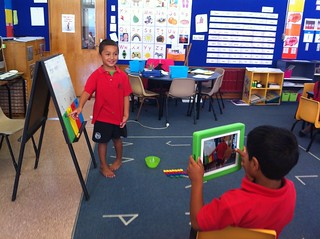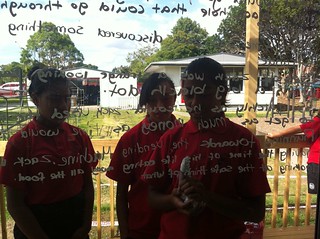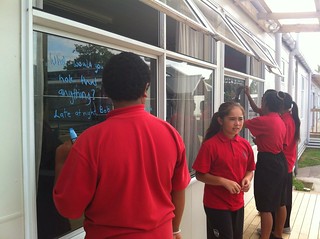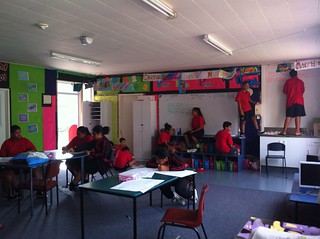Final testing has been completed, students are looking forward to camp, prizegivings and various end of year activities - the teacher is awaiting a well deserved break. Before that I am working on analysing the data and reflecting on a most interesting year.
2013
First year with year 7/8 children - aged 12-13yrs
3rd year in a 1:1 environment using Google Sites to manage learning and blogs for sharing and reflecting.
First year of the Manaiakalani Innovative Teacher's Academy
How has it all gone?
In the beginning my inquiry centered around key competencies, critical self reflection and students monitoring learning and success. Nothing stays still for long at Pt England School and before I knew it term 1 was done. Things were going well, so we changed it all up. This in turn changed a lot of my thinking around my inquiry.
I began to look solely at maths as an area to target as this was the subject I was responsible for teaching my 32 students.
The students in class ranged in ability from operating at a year 2 level through to high school. A challenging task to engage and extend all involved.
I started by looking at the idea of students working in multilevelled groups for problem solving, to learn from one another and strengthen skills of the more able students. I set difficult problems aimed at the upper end of intermediate school.
Teaching equation strategies was not going to help these students, what they needed was targeted lessons around specific ways that would work best to solve the problems.
Each student brings strengths to a group and each student needed to identify those and how best to harness their abilities to support their own learning as well as the wider group. Some students clearly identified they worked best as an individual accessing learning from experts online, whilst others sought assistance from friends in the classroom. Some students knew that discussing ideas helped and others knew thoughtfully processing those ideas quietly was their best approach. Different strokes for different folks, all working alongside one another in a peaceful environment.
What I enjoyed, as the teacher, was listening to students discuss and share their learning with others as they tackled the problem. As well as the thoughtful sharing online between groups of learners. For many students the problem would always be much too difficult and would need to explore ways to assist them solving it.
Each student shares their problem solving on their blog. This has proven to be a wonderful record for Overall Teacher Judgements, rewindable learning for the student and sharing learning for other students to access.
Now, as I look to completing reports and generating my Overall Teacher Judgement on student achievement, I am also looking at the student's ability to self reflect and share learning.
Ultimately, is there a direct correlation between accelerated learning and the sharing and reflecting on learning?
For my class of 29 students I identified 19 who were competent sharers and reflectors. I took the data from student blogs, group activities and anecdotal notes from classroom experiences. Of those 19 students, 15 showed at least twice the national expected gain in mathematics over the year. The remaining 4 made 1.5yrs academic gain in 2013.
Of the remaining 10 students who didn't demonstrate competency in sharing and reflecting, only 2 showed at least twice the expected gain in mathematics.
Not a conclusive result, but certainly one that I am pleased with. Students that are cognitively engaged with the learning process are those making the gains. Those that regularly share learning are making the gains. Students in charge of their learning process are making the gains. These students are not always the traditionally smart kids - they come from across the board.
I look forward to continuing this learning process in 2014. I will have a new group of students and a new chance to try and change the way they experience school and learning.
I will be teaching in a year 3/4 class in a 1:1 environment consisting of iPads and Chromebooks.
An exciting adventure that I am keen to get started on.
Thanks to the Telecom Foundation for this opportunity in 2013 and I am excited to continue this relationship for 2014 as a part of the MIT program.
2013
First year with year 7/8 children - aged 12-13yrs
3rd year in a 1:1 environment using Google Sites to manage learning and blogs for sharing and reflecting.
First year of the Manaiakalani Innovative Teacher's Academy
How has it all gone?
In the beginning my inquiry centered around key competencies, critical self reflection and students monitoring learning and success. Nothing stays still for long at Pt England School and before I knew it term 1 was done. Things were going well, so we changed it all up. This in turn changed a lot of my thinking around my inquiry.
I began to look solely at maths as an area to target as this was the subject I was responsible for teaching my 32 students.
The students in class ranged in ability from operating at a year 2 level through to high school. A challenging task to engage and extend all involved.
I started by looking at the idea of students working in multilevelled groups for problem solving, to learn from one another and strengthen skills of the more able students. I set difficult problems aimed at the upper end of intermediate school.
Teaching equation strategies was not going to help these students, what they needed was targeted lessons around specific ways that would work best to solve the problems.
Each student brings strengths to a group and each student needed to identify those and how best to harness their abilities to support their own learning as well as the wider group. Some students clearly identified they worked best as an individual accessing learning from experts online, whilst others sought assistance from friends in the classroom. Some students knew that discussing ideas helped and others knew thoughtfully processing those ideas quietly was their best approach. Different strokes for different folks, all working alongside one another in a peaceful environment.
What I enjoyed, as the teacher, was listening to students discuss and share their learning with others as they tackled the problem. As well as the thoughtful sharing online between groups of learners. For many students the problem would always be much too difficult and would need to explore ways to assist them solving it.
Each student shares their problem solving on their blog. This has proven to be a wonderful record for Overall Teacher Judgements, rewindable learning for the student and sharing learning for other students to access.
Now, as I look to completing reports and generating my Overall Teacher Judgement on student achievement, I am also looking at the student's ability to self reflect and share learning.
Ultimately, is there a direct correlation between accelerated learning and the sharing and reflecting on learning?
For my class of 29 students I identified 19 who were competent sharers and reflectors. I took the data from student blogs, group activities and anecdotal notes from classroom experiences. Of those 19 students, 15 showed at least twice the national expected gain in mathematics over the year. The remaining 4 made 1.5yrs academic gain in 2013.
Of the remaining 10 students who didn't demonstrate competency in sharing and reflecting, only 2 showed at least twice the expected gain in mathematics.
Not a conclusive result, but certainly one that I am pleased with. Students that are cognitively engaged with the learning process are those making the gains. Those that regularly share learning are making the gains. Students in charge of their learning process are making the gains. These students are not always the traditionally smart kids - they come from across the board.
I look forward to continuing this learning process in 2014. I will have a new group of students and a new chance to try and change the way they experience school and learning.
I will be teaching in a year 3/4 class in a 1:1 environment consisting of iPads and Chromebooks.
An exciting adventure that I am keen to get started on.
Thanks to the Telecom Foundation for this opportunity in 2013 and I am excited to continue this relationship for 2014 as a part of the MIT program.
















